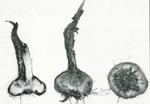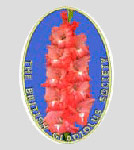The British Gladiolus Society
Pests and Diseases
plant species go, the gladiolus is relatively free of pests and diseases of epidemic proportions: however, as with all subjects it is vulnerable to certain fungi, virus and insect damage. Below is a summary of some of those that are more likely to be encountered in no particular order of their threat. The common prevention message as far as all are concerned is to destroy all infected or suspect tissue whether leaf or corm - do not compost.
Storage Rot Penicillium spp.
Corms may become soft during storage or appear to be covered with bluish-green masses of fungal growth. Control involves careful selection of clean, well-ripened corms for storage during digging. These corms should be cured for three weeks at 80 F, with artificial heat if necessary. It is also helpful to carefully inspect the corms after storage and to destroy any corms that don't appear healthy.
Caterpillars
Caterpillars can also be a pest and when present will often attack flower buds hewing a hole through the entire bud and thus the petals held inside. In addition they may also emerge from the tips of a spike in tight buds generating further holes which will detract from the beauty of the plant.
Scab Pseudomonas.

The first symptom of infection is the appearance of tiny, reddish-brown, raised dots on the basal part of the leaves. These spots enlarge and coalesce to form longitudinal lesions or streaks. Under favorable weather conditions, large, brown, dried areas develop on the leaves. These are followed by a rot of the stem at or just below ground level. Lesions on the corms are light-colored, watery spots at first and become darkened with a raised margin, the center of which shows a hard, gummy exudate which is shiny and reddish. The most effective method for control of this disease is selection of a site with well-drained soil. It is also very important to discard any corms that show disease symptoms.
Stromatinia Rot
This corm disease is caused by a fungus called Stromatinia gladioli and is most prevalent during periods of cool wet weather and as such can be a particular problem in northern European climates.  The first signs of disease are usually on the growing plant and are evident by the yellowing of leaves which eventually shrivel and die. Evidence of the disease on the corms is the appearance of reddish brown markings which are sunken and if the corm is dissected,
dark markings are seen as a marbling emanating from the centre. A particular problem with this disease is that the fungus produces an over wintering particles called Sclerotia.
As a result diseased corms should never be planted and as a precaution corms should always be harvested in dry conditions. If Stromatinia is suspected in growing plants that soil should not be replanted in subsequent
years as the disease is capable of passing from soil to plant.Read more
The first signs of disease are usually on the growing plant and are evident by the yellowing of leaves which eventually shrivel and die. Evidence of the disease on the corms is the appearance of reddish brown markings which are sunken and if the corm is dissected,
dark markings are seen as a marbling emanating from the centre. A particular problem with this disease is that the fungus produces an over wintering particles called Sclerotia.
As a result diseased corms should never be planted and as a precaution corms should always be harvested in dry conditions. If Stromatinia is suspected in growing plants that soil should not be replanted in subsequent
years as the disease is capable of passing from soil to plant.Read more
Fusarium Yellows and corm rot
This disease is caused by the fungus Fusarium oxysporum,  var. gladioli and is often referred to as Fusarium yellows or Fusarium Wilt. The symptoms are a yellowing of the leaves starting with the older outside ones first and this is accompanied by the apparent
stunting of newer leaves. In addition the spike itself will often be stunted and faded in colour. The plant may also have blackened areas at the base which spread onto the corm. Eventually, if left, the whole plant will wilt and when lifted for destruction,
(for this is the only course of treatment), the interior of the corm when opened will appear marbled with a brown colour.
var. gladioli and is often referred to as Fusarium yellows or Fusarium Wilt. The symptoms are a yellowing of the leaves starting with the older outside ones first and this is accompanied by the apparent
stunting of newer leaves. In addition the spike itself will often be stunted and faded in colour. The plant may also have blackened areas at the base which spread onto the corm. Eventually, if left, the whole plant will wilt and when lifted for destruction,
(for this is the only course of treatment), the interior of the corm when opened will appear marbled with a brown colour. Where Fusarium occurs, fertilize sparingly: nitrogen should be applied in the nitrate form rather than as ammonia or urea. Soil pH 6.6 - 7.0 preferred. Harvest corms in dry weather if possible and cure them rapidly using forced air at 80 - 100"F if available.
Inspect stored corms and rogue out suspects.
Where Fusarium occurs, fertilize sparingly: nitrogen should be applied in the nitrate form rather than as ammonia or urea. Soil pH 6.6 - 7.0 preferred. Harvest corms in dry weather if possible and cure them rapidly using forced air at 80 - 100"F if available.
Inspect stored corms and rogue out suspects.
Read the second part of Pests and Diseases
